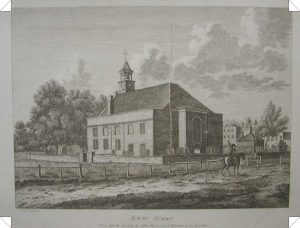St Anne’s Church, Kew Green – [Local History Notes: 4]

The hamlet of Kew had a chapel in the 16th century, but this was the private chapel of Thomas Byrkis at Kew Farm and the licence granting permission for divine service and Eucharist to be held there covered only the lives of Byrkis and his wife. It was given in 1522 and discontinued in 1534.
In 1710, the inhabitants of the hamlet (at that time in the Parish of Kingston) resolved to build a ‘chapel of ease’. A petition supported by the Vicar of Kingston was made to Queen Anne – the Lady of the Manor – who gave her assent and presented the petitioners with a site on Kew Green plus £100 towards the cost of the chapel and cemetery. The Queen followed the progress of the building, visiting on her journey to and from Windsor. The church was dedicated to St. Anne on 12th May 1714.
By 1769 the population of Kew had expanded due to the royalty and the court living there. The chapel was too small, so the church was enlarged in 1770 from a design by Joshua Kirby (1716-1774) and at the expense of George III. The nave was lengthened and north and south aisles added. The south aisle, however, was separated from the rest of the building and accommodated a charity school, the lodging of the beadle, and the sexton’s house. The living was also upgraded from a curacy to a parish, although the vicar was still responsible for the parish of Petersham until 1788.
In 1805 George III arranged for a gallery to be erected to hold his large family when they attended services. This gallery was lengthened in 1810, when the south aisle ceased to house the school and residences and became embodied in the church.
Vestries and stairways were added gradually till 1836. There was no chancel at this time: the altar was separated from the pews merely by a rail. The organ was situated above the altar.
William IV arranged for the remodelling of the west front in 1836 from designs drawn by Sir Jeffrey Wyatville. Further restoration and enlargement occurred in 1884 when a south porch and chancel were added. Coloured windows were added later.
The interior of the church contains a number of ‘hatchments’ – panels painted with armorial bearings – including those of George III’s sons Adolphus, Duke of Cambridge and Ernest Augustus, Duke of Cumberland.
A series of hassocks — tapestry-worked cushions — illustrating the history of Kew have been made by a group of lady members of the church. The project was begun in 1962 by George and Kathleen Cassidy to celebrate the church’s first 250 years.
Several notable persons have been buried at St. Anne’s, including Sir William Hooker (1775-1865) the first Director of Kew Gardens and his son Joseph (1817-1911) who succeeded his father as Director. Thomas Gainsborough (1727-1788) is one of a number of artists interred there. Three of these had royal appointments under George III: Joshua Kirby (already mentioned above) was architect as well as artist and Royal Drawing Master; Jeremiah Meyer (1735-1789), the Queen’s miniature painter also designed the profile of George III used on the new coinage of 1761; Francis Bauer (1758-1840) held the post of botanical artist to the king. Also buried in the church is John Zoffany (1733-1810) whose painting Last Supper was originally painted for St. Anne’s, given to St. George’s Church, Brentford and now hangs in St. Paul’s Church, Brentford.
The Duke of Cambridge, uncle of Queen Victoria, died in 1850 at Cambridge Cottage, 37 Kew Green and was buried at St. Anne’s. The following year, 1851, his son ‘erected a little mausoleum at the east end of the church’. During the 1930s the royal remains were taken to Windsor and re-interred in the royal mausoleum at Frogmore.
More information on St Anne’s Church and other historic buildings in the London Borough of Richmond upon Thames is available from the Local Studies Library & Archive.
Suggestions for further reading
Blomfield, David / Kew past. 1994
Cassidy, George / The architectural history of St. Anne’s Church, Kew Green. 1986 (Richmond Local History Society, Paper no.3)
Cassidy, George / The Chapel of St. Anne, Kew Green 1710-1769. 1985 (Richmond Society History Section, Paper no.2)
Courlander, Kathleen / Richmond: from Kew Green to Ham Common. 1953
Johnston, Mary S. / The evolution of Kew Church (St. Anne’s). 1948
Royal Hatchments in City Churches (Transactions of the London and Middlesex Archaeological Society. New series v.10, Pt.1).
St. John, Rowland / Kew Parish Church (St. Anne’s). 1948
